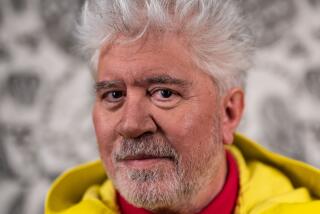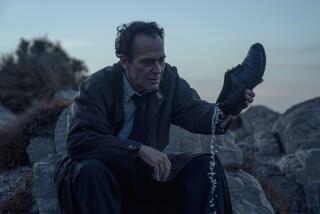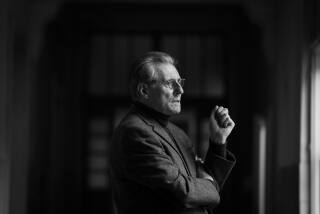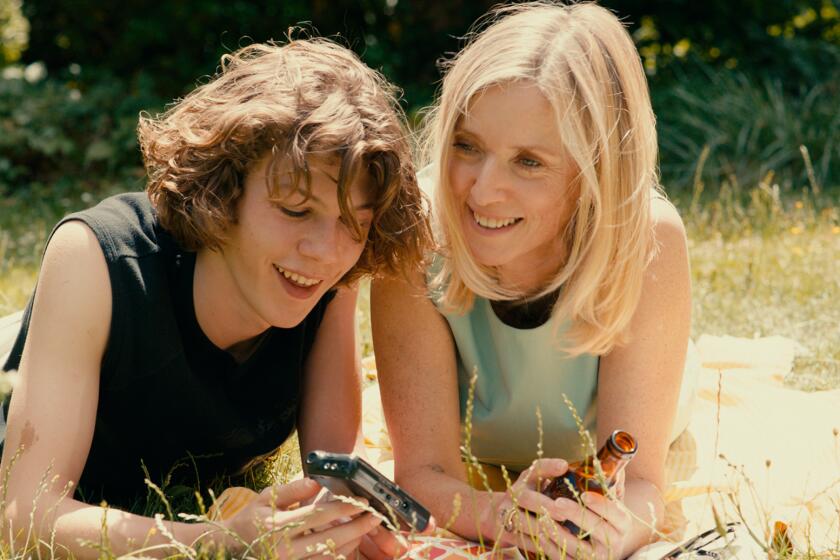Alejandro Jodorowsky’s renewal continues with ‘The Dance of Reality’
The recent documentary “Jodorowsky’s Dune” left audiences with the picture of an artist who snatched personal spiritual victory from the professional defeat of a famously unrealized project. Now, as in an old-time adventure serial, the story continues with Alejandro Jodorowsky’s first film in more than 20 years.
“The Dance of Reality” is something of a psychological and emotional memoir, based on the filmmaker’s boyhood in the small Chilean coastal town of Tocopilla, but building to something more fantastic and poetic. His son Brontis stars in the role of Alejandro’s father, Jaime, who bullies and badgers his young son (Jeremias Herskovits) and voluptuous wife (opera singer Pamela Flores) while caught up in local political intrigues. Alejandro Jodorowsky also appears as his older self, a combination shaman, chorus and narrator throughout the film. The film contains many images and moments — of dwarves, miners, dictators, clowns, amputees — that outrageously mix the ridiculous and the tender.
In the years since the unrealized adaptation of “Dune” in the 1970s covered in the documentary and his 1990 film “The Rainbow Thief,” a lackluster job-for-hire starring Peter O’Toole and Omar Sharif, Jodorowsky has stayed busy. He has published countless comics and other books, held a number of art exhibitions, been involved in theater, taught courses on tarot reading and given lectures on a form of therapy he calls “psychomagic.”
“If I don’t stop, I can’t die. I need to do these things. I am working, I am alive,” Jodorowsky, now 85, said recently by phone from his longtime home in Paris, his voice full of enthusiasm and an infectious sense of wonder. “But inside me, I am not old. The exterior is a little old, my body is a little old. But in my mind, not.”
“It’s like a river, if something is blocking the way, it flows somewhere else,” said Brontis Jodorowsky of his father’s circuitous artistic output. “He loves making cinema, it’s the place where he can express the most as an artist.”
Well before his recent reemergence via the “Dune” doc and “The Dance of Reality,” Jodorowsky has long been a revered figure in cinema circles. His early 1970s films “El Topo” and “Holy Mountain” are considered foundational works in establishing the alternative midnight movie circuit, with their eye-popping visual style and allegorical storytelling. In their influential book “Midnight Movies,” J. Hoberman and Jonathan Rosenbaum declared Jodorowsky “a counterculture unto himself.”
Playing now in Los Angeles, “The Dance of Reality” has been received with a sense of excitement renewed. In The Times, reviewer Robert Abele called the film “exquisitely attuned to the commingling of the bitterly funny and tragic … proof that the legendary provocateur is still a font of out-there invention.” In the New York Times, critic A.O. Scott called it “something very close to a masterpiece.”
“The Dance of Reality” premiered last year at the Cannes Film Festival, where “Jodorowsky’s Dune” also first played. Premiering at that festival was also “Only God Forgives,” starring Ryan Gosling and written and directed by Nicolas Winding Refn, who dedicated his film to Jodorowsky.
Musician Kanye West has acknowledged “Holy Mountain” as a key influence on the visuals and staging on his most recent tour, but Refn has become perhaps the most dedicated acolyte of Jodorowsky. Refn visited Jodorowsky in Paris before beginning both “Drive” and “Only God Forgives” for tarot readings as to their prospects that he says proved startlingly prescient.
In an interview last summer Refn noted, “I’m of course a huge admirer of his work as a filmmaker, to the point of saying he is one of the most influential figures of pop cinema. I think without his ‘El Topo’ there would be no pop cinema.”
The roots of Jodorowsky’s late-period renewal with “The Dance of Reality” are in revisiting the failure of an adaptation of Frank Herbert’s novel “Dune” that he was unable to make. In the process of shooting interviews for Frank Pavich’s documentary “Jodorowsky’s Dune,” Jodorowsky was reunited with his producer on that ill-fated project, Michel Seydoux. The two had not spoken in decades, but they came to realize they wanted to try to collaborate again. So after years away from cinema, returning to Jodorowsky’s biggest career disappointment inspired plans to make a movie again.
Adan Jodorowsky, who has a successful music career in Mexico performing under the name “Adanowsky,” also appears in “The Dance of Reality” and composed his first film score for his father’s movie. Drawing inspiration from the scores to “El Topo” and “Holy Mountain,” he recorded on vintage instruments and equipment.
Both sons found the process of making “The Dance of Reality” to be deeply moving for themselves and their father. “It created a bridge. It was like a healing session, a therapy session,” said Adan from a bus while on tour recently in Mexico. “After this movie, something changed in us. It was incredible. It’s rare to work with this kind of magic.”
“‘El Topo’ or ‘Holy Mountain,’ for me they are a kind of ritual, the purpose was to open the mind, and to break the mind barriers that he had,” said Brontis Jodorowsky. “But this movie, ‘The Dance of Reality,’ for me this movie was more about opening the heart. So it’s a much more emotional experience.”
The film ends with Alejandro Jodorowsky himself sailing away on a boat with a figure dressed as a skeleton, leaving behind all the characters from the film. Though the most obvious interpretation of such an image might be grim, Brontis points out that the skeleton can be seen as a figure of transformation.
So for Alejandro, “The Dance of Reality” goes on.
“If I die it is my testament, if I don’t die it is my comeback,” he said. “I see it as the beginning of something.”
More to Read
Only good movies
Get the Indie Focus newsletter, Mark Olsen's weekly guide to the world of cinema.
You may occasionally receive promotional content from the Los Angeles Times.











